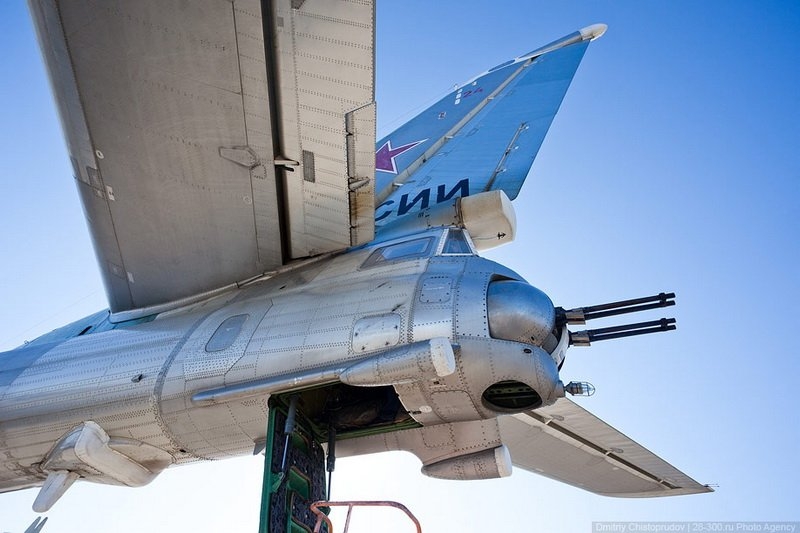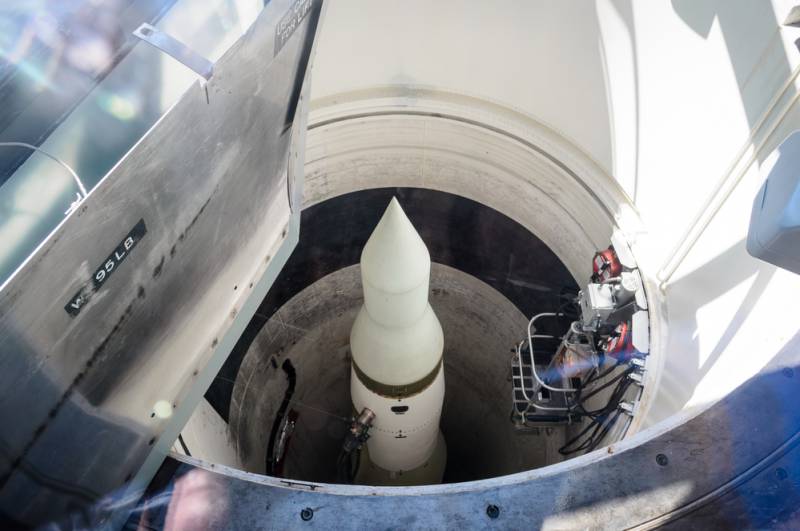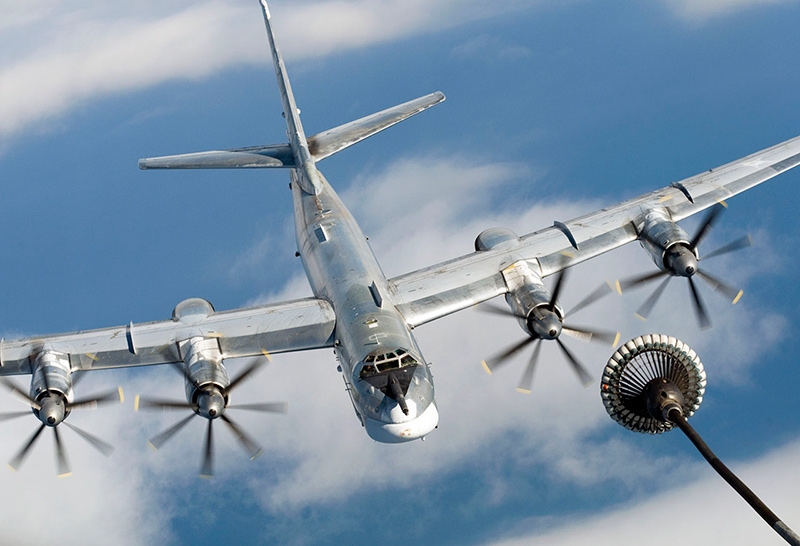
Tu-95 (NATO codification: Bear - «Bear») - Soviet and Russian turboprop strategic bomber-rocket carrier, the fastest in the world aircraft engines with screw. Until now - the world's only serial bomber and missile carrier turboprop.
Tu-95MS "Bear" – video
He was a symbol of the Soviet ensuring strategic parity in the Cold War. It remains in service as a carrier of cruise missiles, including such, as X-101, due to lower fuel consumption, than the jets, and most importantly - the most secretive of SBIRS satellites, can watch the large strategic bombers with jet engines on the exhaust emissions of the last. National Interest notes, which is rather naively assumed Tu-95 "obsolete weapons", as in fact by such aircraft do not need anything, but to fly long-range, and his real weapon is the latest stealth cruise missiles - such as the X-101, range at which 5500 km allow the Tu-95 "with impunity" to attack targets outside the radius of action of any air defense systems. Practical application of the Tu-95 proved in Syria, that the plane is not "abstract nuclear deterrent", but it can actually be used in modern local wars.
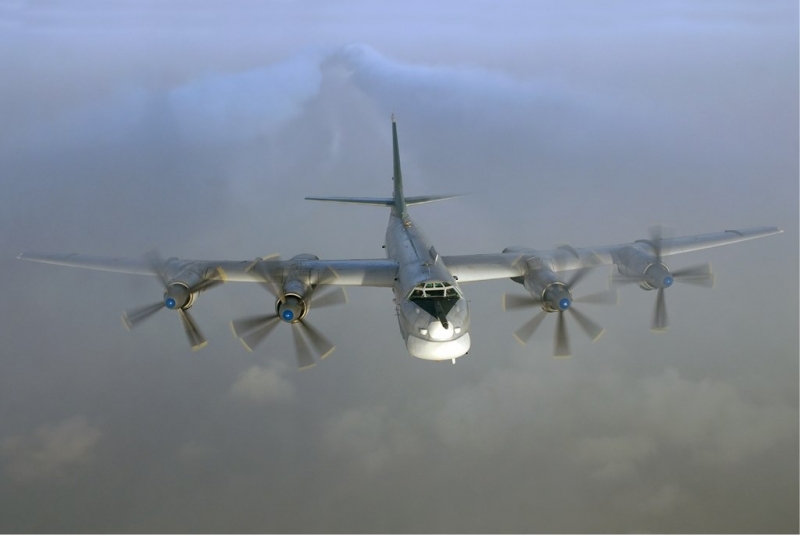
Total developed aircraft "95" for this, including serial modifications, prototypes, flying laboratories and unrealized projects, nearer to fifty, and the total number of cars produced - to 500 meals.
Based on modifications of the Tu-95 were created flying laboratory for various purposes, Intercontinental passenger jet - Tu-114 and its design transport version. In its turn, combat aircraft AWACS was created based on the Tu-114 - Tu-126. Direct development "95" project at a higher technical level of aviation was an option ASW aircraft, which formed a series of modification a number of aircraft Tu-142 different combat supplies.
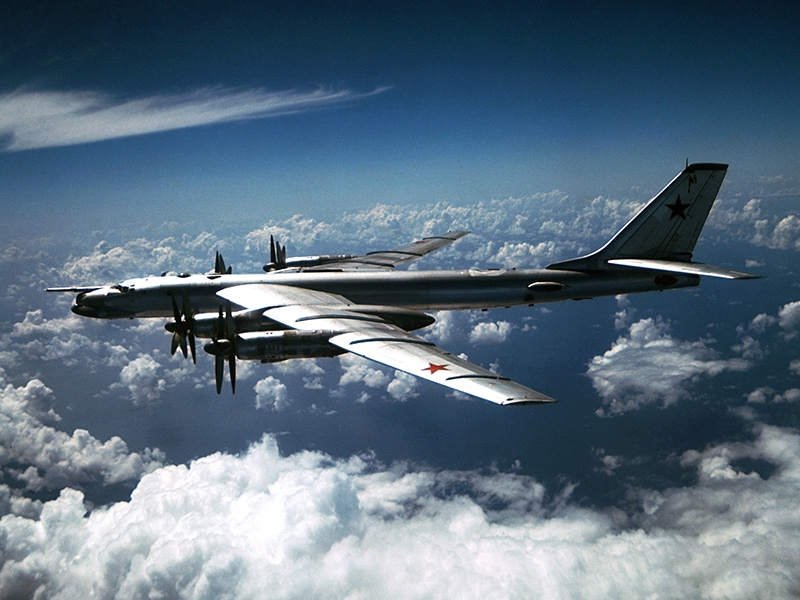
story
In the early 1950s, the party and state leadership of the USSR feared the threat from the United States, who already had a turbojet-piston intercontinental strategic bombers Convair B-36 Peacemaker, while a part of the Soviet Air Force bombers were only piston medium-range Tu-4 - a copy of the American B-29. Given this situation, at 1951 he published a decree of the USSR Council of Ministers № 2396-1137 and the order number of the Ministry of Aviation Industry 654, who demanded like Soviet strategic bomber as soon as possible to develop, which could reach US territory and attack enemy nuclear weapons. To develop a new aircraft design bureau was tasked A. n. Tupolev.
AT 1951 , the Air Force approved the Commission developed a draft, In December of the same year it was approved and endorsed the plane layout. The aircraft factory № 156 (Moscow) It began construction of two prototypes of the aircraft "95".
The first prototype T 95 makes a first flight 12 November 1952 of the year, Test Pilot - A. D. Flight.
Serial production began in 1955 year. The series were Tu-95, further strategic reconnaissance Tu-95MR; distant aircraft reconnaissance and target designation Tu-95RTS; strategic missile-carrying aircraft Tu-95K and TU-95km.
Built Tu-95 of various modifications were in service prior to the beginning of the 1990s., passing a number of major works of modification and modernization of engines, composition of weapons and equipment.
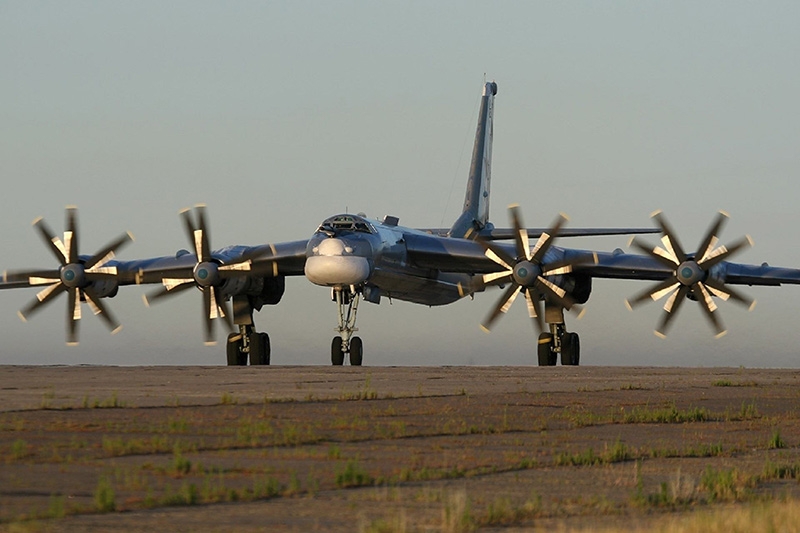
Design
All modifications TU-95 are four-engine-metal monoplane with swept wing and empennage, three-point retractable landing gear and two pressurized cabin, front and rear.
Note. Description of the aircraft structure is given in relation to the family of B - the old modifications of the Tu-95M, KM, RC and t. P. Currently operating a modification of Tu-95MS (VP-021) It refers to the family of the EP (Tu-142) and substantially different from decommissioned previous versions, since the aircraft was created on the basis of anti-aircraft Tu-142M (VPM) and the prototype was called Tu-142MS. Glider and obschesamolotnye system Tu-95MS largely correspond to anti-model.
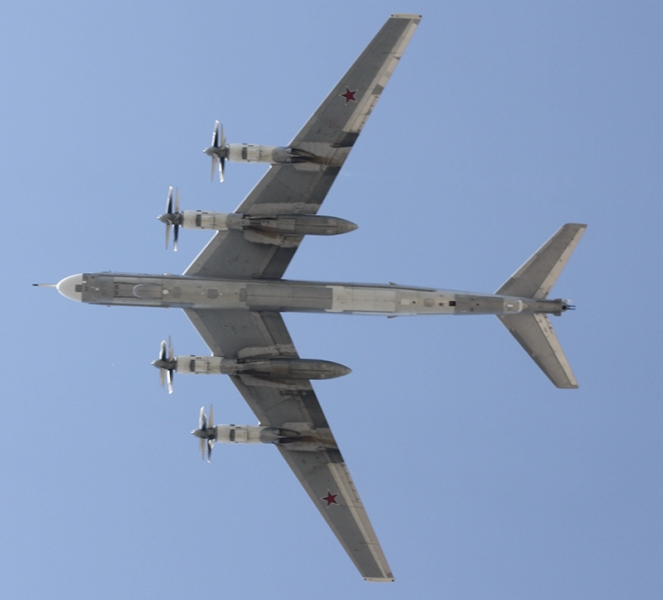
Tu-95MS during the parade 9 May 2010 g
Glider aircraft
The basic structure of an aircraft airframe material are aluminum alloys D16 and V95, steel 30KhGSA and 30HGSNA (power units, Connecting and mounting parts), ML5 T4-magnesium-lithium alloys.
The fuselage of circular cross-section with a stressed skin, set of frames and stringers. Fixing cladding - countersunk rivets, Butt seams are. The fuselage structure includes a number of force elements, increasing its strength and stiffness in the cargo compartment area, at the entry hatch and the point where the front chassis legs. Technological divide the connectors on the fuselage section: nasal lantern F-1; fore, It includes a cabin front sealed F-2 (nm. № 1÷13); average unsealed portion F-3 (nm. № 13а÷49); tail unsealed part of F-4 (nm. № 50÷87); feed pressurized cabin F-5 (nm. № 87 ÷ aft gun mount); fairing aft gun mount.
Nasal lantern F-1 and the nose of the fuselage F-2 together form a front pressurized cabin, which houses the crew working places. The lower part of fuselage section P-2, under the floor of the workplace navigator, set closed radome radar antenna, and between wp. № 6÷13, under the car floor is formed compartment front landing gear. The front strut is retracted into the fuselage of the flow path and closes the two pairs of flaps. Entrance to forward cabin is carried out on a ground ladder (stairs) swiveling through a hatch in the cabin floor, driven by a pneumatic cylinder. Hatch is equipped with a mechanism for emergency opening (actuated simultaneously with the emergency release of the nose landing gear) and device, Cleared overpressure in the cab. To facilitate the emergency evacuation of the aircraft crew, in the cockpit of a movable floor with hydraulic accumulator and from the cross-hooks for hands.
Bow front lights and windows sealed cabin glazed and partially organic silicate glass. Bottom flat sloping windscreen window nasal lantern navigator and front windows overview pilots have silicate triplex glazing, electric,, other windows from plexiglas. The side windows have jobs flight engineer and navigator-operator performed in discharged emergency hatches - to enable the rapid evacuation of the cabin, if it is impossible to leave the aircraft through an access hatch. In the upper part of the cabin, near trowels. № 13, set with a round transparent blister ring sighting station BC-153VK upper gun mount. In front of the pressurized cabin housed various devices, aircraft controls, aeronavigatsionnoe, high-rise and other equipment.
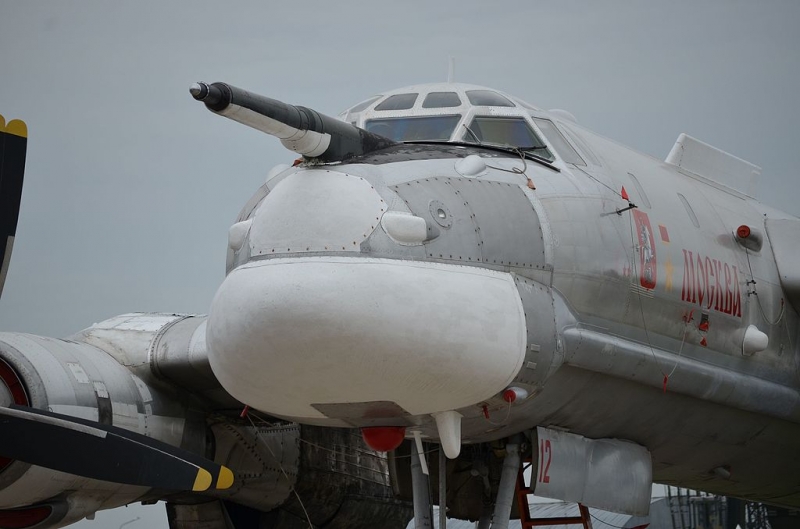
The forward fuselage of the Tu-95MS
The crew of the aircraft 7-11 human (depending on the modification). for example, Tu-95MS - commander, Assistant captain, ship navigator, second ship navigator, operator onboard communications (BSS), flight engineer, the commander of the firing plants (KOU). Tu-95RTS - commander, Assistant captain, senior flight engineer, navigator navigator, navigator-operator (equipment "Success-U"), the second operator of the equipment "Success-U", SBD operator (superfast equipment "Shark"), RTR operator (ELINT), senior gunner-radio operator, operator stations intercept "Cherry" and FPC.
To the middle of the fuselage F-3 (between trowels. № 19÷28) center-mounted wing, followed by (between trowels. № 28 ÷ nm. № 45) It is warmed and heated gruzootseke (bomb bay), Enclosed two pairs of wings. On a Tu-95RTS in place gruzootseke is a technical compartment equipment "Success-U".
for nm. № 45 Aiming is a compartment lighting bombs, wherein the cylinders are also located onboard the aircraft fire system. Most of the rest of the volume fuselage section F-3 occupied by the containers of soft fuel tanks (№ 1, 2, 3, 6a, 6b). On the left side (between trowels. № 14 and number 17), closer to the outer surface of the fuselage, two containers fitted with rescue boats LAS 5-2M. Along the sides of fuselage section 3a F-tested traction cables and control wiring plane, placed a number of electrical units. Inside the rear fuselage section (compartment) F-4 are disposed soft fuel tanks (№ 4, 5, 5a), neutral gas cylinders, Hydraulic systems and oxygen equipment, for industrial service hatch which is made, mounted upper and lower tower shooting guns, additional tail landing gear.
Top mounted forkil, the nodes on the power trowels. № 81 and number 87 attach the stabilizer fin and tail. The stern pressurized compartment F-5 are jobs commander firing installations (KOU) and air radio operator-gunner (ON WEDNESDAY, on the modification of the Tu-95RTS - operator of electronic intelligence). For load-bearing frames are mounted aft of the pressurized cabin aft gun mount and top - sighting radioloktsionnaya station IRS-1. For an overview of the lateral hemispheres and the possibility of fire in the pressurized cabin aft sides has two large blisters droplet of organic glass with two sights stations bottom gun mount. Aft cabin windows glazed transparent armor - selikatnym triplex. On the left side is placed glassed escape hatch, on the right - the inspection window. Aft cabin access door is opened using a cylinder of compressed air and forth down the flight.
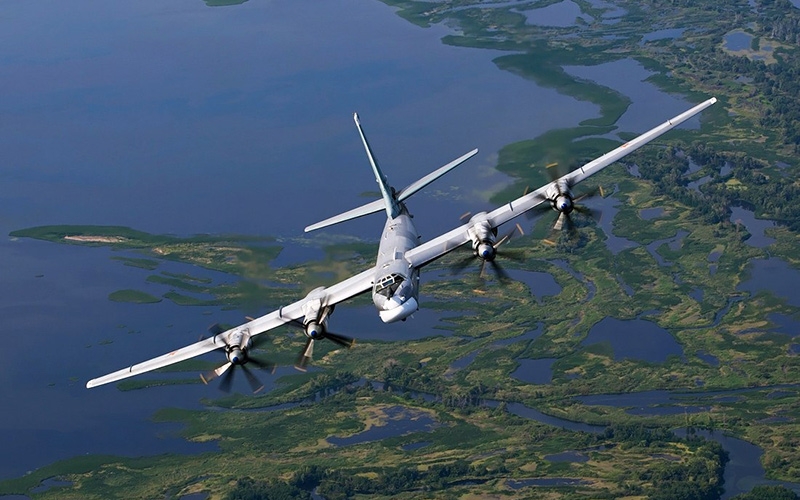
Wing
The wing consists of caisson type of center, two medium and two external ock ock. It has variable sweep on the line of focus (25 % lengths of the chords), in the central part of the wing and 35º end portion 33,5º. Reducing the sweep angle end portion of the wing due to the use of a lower relative thickness airfoils (aerodynamic twist), It is providing sufficiently high values of the critical Mach numbers (md) for smaller values the sweep angle of the wing, and decrease in mass. In order to ensure acceptable takeoff and landing aircraft performance at the trailing edge of the wing flap mounted odnoschelevoy retractable motorized and complete release angle 30 degrees. Structurally flaps consist of two inner and two outer sections.
On the wing are four protruding far forward nacelle, providing an aerodynamic wing discharge and perform the function of cargo protivoflatternyh. Pairing the engine nacelles to the wing performed by space rule, inside the nacelle fairings are structurally united with the main landing gear pods.
Wing caisson formed by the front and rear spars beam type, the upper and lower panels with thick stressed skin, backed by powerful stringers. All of the wing (center section, Ock-1 and-2 pts) interconnected flanged (fitting) bolted: on belt spar, the contour of the panels and the walls of the side members. The caisson, between the ribs, posted 66 soft rubber fuel tanks. The top panel formed nacelle attachment assemblies. Bottom panel in places of the main landing gear attachment points reinforced by two beams. The upper and lower panels POINTS-1 and-2 are POINTS manholes for access to the control wiring, Fuel transfer pump, Fuel gauge, fuel filling hatches manholes and hatches emergency fuel drain valves.
Along the entire span of tail portions disposed external POINTS trohsektsionnye ailerons, with an inner aerodynamic and weight compensated. At the root section of the aileron trim set-servo tab. On the upper surface of the wing planes set of three aerodynamic ridge. In wingtips installed onboard navigation lights Bano-45.
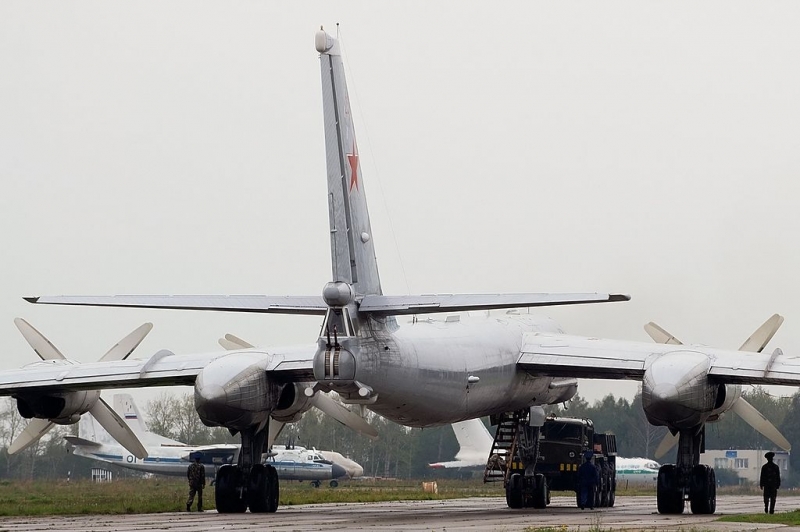
View from the tail Tu-95MS
tail
cantilever, single-fin, swept, all-metal, decompression design. The angle of sweep of the vertical and horizontal tail 40 degrees quarter chord line. Stabilizer kessonnooy design, fixed (installation angle -2,5º), It comprises two halves, stacked together on the aircraft axis. The design of the stabilizer is designed taking into account the possibility of changes in the flight, however stabilizer permutation mechanism in the early versions of the Tu-95 was not raised, Tu-95MS applied permutation mechanism with electric drive for expansion of operating centering range. Structurally, elevators and rudder are made up of the spar, set of ribs and skins, trailing edge "knife" magnesium alloy. The elevator consists of two halves, interconnected driveshaft, It has a 30% aerodynamic axial compensation and compensation by weight to 3% rebalancing. On each half of the elevator trim set with manual and electrical control. The rudder has a 30% aerodynamic axial compensation and compensation by weight with a 2% rebalancing. On the rudder trim set-servo tab Power.
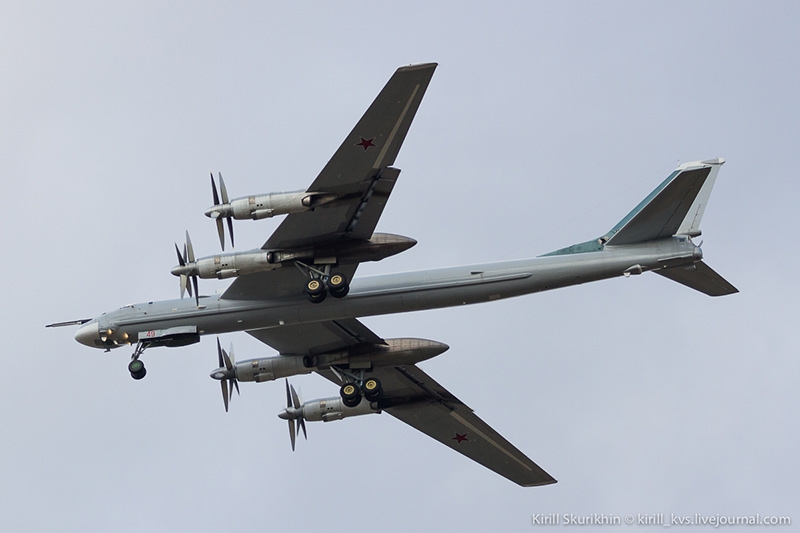
Chassis
aircraft landing gear - tricycle. Front Bearing with two controlled non-braking wheels dimension of 1100 × 330 mm (charging pressure pneumatics - 9 kg / cm²), in flight in the retracted niche in the front of the fuselage and closed by two pairs of flaps. It is equipped with a shock absorber gidroazotnym (Working fluid oil AMG-10, charging pressure of nitrogen - 27 kg / cm²). Turning control wheel on the front foot directional control pedal in the pilots.
Basic rack each have four pairs of brake wheels. All wheels are equipped with disc brakes with automatic antiyuzovym. Main landing gear retracted into the wing nacelle while coup carts and five closed doors. All three pillars are produced upstream, front support - hydraulic system with the nominal pressure 150 kg / cm2 or emergency pneumatic system, basic support - two-channel (sdvoennыmi) electromechanism MPSH-18MT with DC motors 27 The capacity 2600 Watt each. Opening of locks retracted position - DC solenoids, two solenoid per lock, There STOP Rope opening locks and an emergency release of racks with a hand winch. All TU-95 variants can be split (alternately) cleaning / release of the main landing gear.
All TU-95, MS modification except, for the prevention of the rear fuselage of the pin, in the case of improper seating, Lower aft mounted retractable in-flight more two-wheeled support with built-in hydro-nitrogen cushion, with additional braking to move backward, and pneumatics tires with a size of 480 × 200 mm. Tail wheel retracted into its niche electric mechanism MP-250 and closes a pair of small wings.
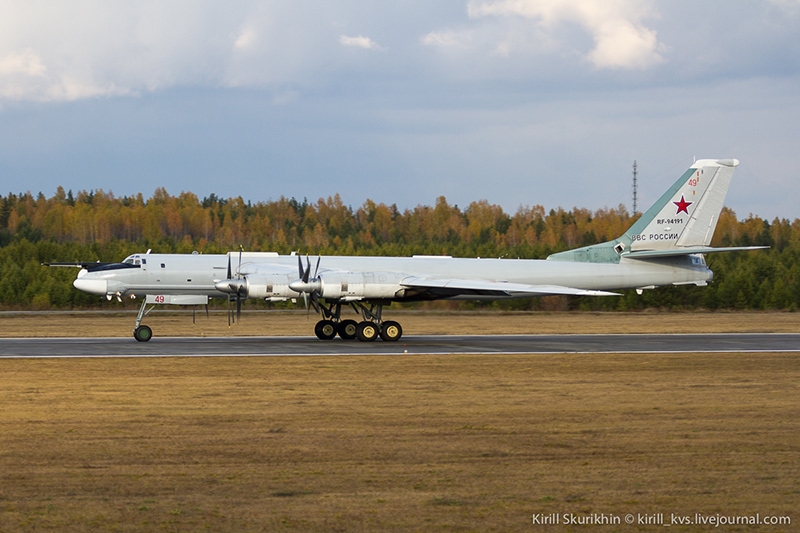
Means of emergency escape and rescue
Ejection seats for the crew members of the Tu-95 is not provided. Emergency leaving the front of the aircraft pressurized cabin via the hatch, located in a niche nose landing gear. The front support forcibly discharged, and the cab floor, It built a conveyor belt with hooks for hands, It is driven by accumulators and theoretically allows the aircraft to leave the incident at large longitudinal accelerations. Exiting rear pressurized cabin is provided through a rear entrance hatch disposable pressurized cabin. When the emergency ditching crew can use 3 inflatable boats LAS-5M (Tu-95MS rafts PSN-10).
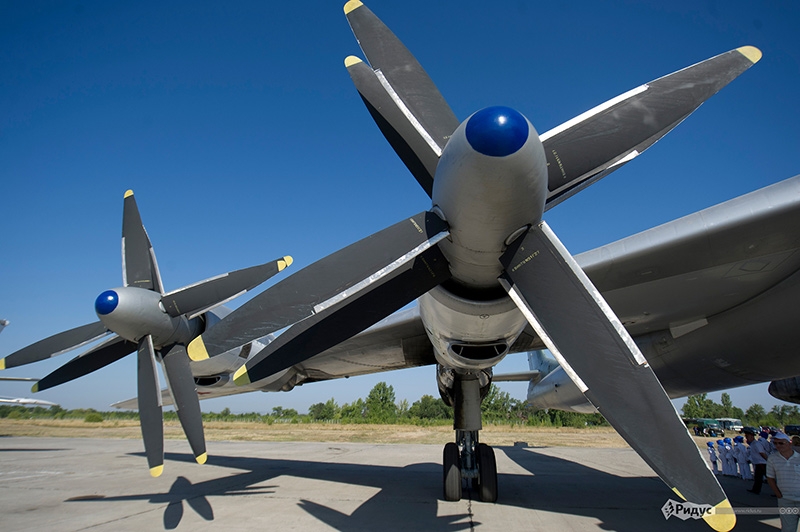
Power point
Tu-95 went into the series with engines NK-12, developed at the State Union Experimental Plant number 2 Ministry of Aviation Industry of the USSR under the direction of designer H. D. Kuznetsova, and manufactured in the Kuibyshev motor plant named after Frunze (Now combined in PJSC "Kuznetsov").
NK-12 engine is still the most powerful turboprop engine in the world.
SC-12 is a 14-stage compressor and a five-stage high-efficiency turbine. To adjust for this engine compressor first set of air bypass valve system. turbine engine efficiency of SC-12 is 34 %, which is a record. The engine NK-12 was first applied to a common fuel control system, constructed in a single unit (the so-called command-fuel unit KTA-14).
Torque transmission on coaxial aircraft bolts provided a unique single-row planetary gear differential, the creation of which he immediately put his hand H. D. Kuznetsov. a number of unique technical solutions has been used in the design and manufacture of gear, later found wide application in other types of aircraft engine.
Coaxial screws with variable pitch type AB-60 of various modifications and series, installed on the Tu-95, have a diameter 5,6 meters and have been developed in OKB-150 (later, Stupino Machine Building Design Bureau, now - NPP "Aerosil"). The head of the OKB-150, TO. AND. Zhdanov, I received 1957 year for their development of the Lenin Prize. Pulling propellers, coaxial, counter-rotating at an angular velocity 736 rev / min (front - clockwise, rear - anticlockwise), 4-lobed, adjustable pitch.
Engine NK-12MV
Each screw consists of two sleeves, front and rear. Each sleeve screwed on the 4 th blade. The front hub is hung kok, rear sleeve closes ribbons. The total weight of construction screws 1190 kg.
Through the main gearbox to the front screw is passed 54,4 % capacities, on the back screw - 45,6 % engine power. The bearing surface formed duralumin blades airfoil NACA-type 16. Change pitch propellers made gidromehanizmom, associated with the rotor speed control. Icing system of the front edges of the blades and screws Coca - Electricity AC 115 AT 400 Hz (subsequently replaced by the more powerful, on-board network 210 volt 400 Hz). Electric current is supplied via a common current collector for adjustable screw sleeve and further, two current collector, the hub of the front propeller.
Engines NK-12 and NK-12M had only manual system feathering propellers. Subsequently NC motor modification was established 12MV, equipped more reliable system of "variable speed automatic feathering" propeller, It triggered at the fall of the torque on the motor shaft. In addition to the basic system of automatic feathering engines were equipped with a system of forced feathering and backup emergency feathering by the forced supply of compressed nitrogen into the oil system of the propeller hub.
High engine power and screw design determines its unprecedented noise - Tu-95 is one of the noisiest aircraft in the world and even pinpoint the sonar systems of submarines, however, this is not a critical factor in applying nuclear missile strikes.
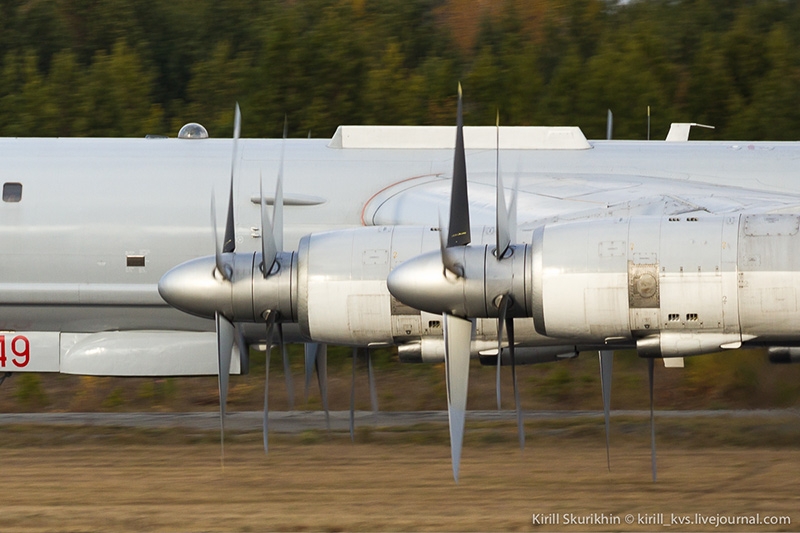
Application on the Tu-95 HPT and economical installation with an efficiency of screw 82 % It led to quite a high performance range of flight, despite relatively low aerodynamic aircraft quality.
Each engine has its own closed oil system with 205-210 liters of oil MH 7,5U (or maslosmesi, consisting of 75 % MS-20 oil or MK-22 and 25 % MK-8p). The oil tank, made from oil-resistant rubber and housed in a semi-circular container, which is part of the lower hood structure, holds up 135 liters of total oil. Temperature is supported automatic oil-air radiator. Due to the relatively high oil consumption engines the lower surface of the wing of the exhaust pipes, gondola landing gear and main landing constantly covered with greasy black soot.
Starting the engine is made by alternately airfield DC source with a voltage 27 volt. Elektrostartor spins and launches turbostartor TC-12, which the, in its turn, spins the turbine engine. More modern NC motor modification 12MP may run pairwise - simultaneously one right and one left, for this two tachometer turbostartorov and two fuel cutoff button are mounted on a flight engineer panel - for engines 1-2 and 3-4. Turbostartor it installed on the left, and when you start the engine exhaust flap opens automatically turbostartora electrically driven mechanism MT-100MT.
Each motor has an autonomous system icing inlet guide vanes. When triggered CO-icing sensor 4A is heated by hot air BHA, bleed from the engine.
On a part of TU-95MS forkil installed in the auxiliary power unit TA-12.

Fuel system
Used soft rubber tanks, located in the fuselage, in the center section and the wing otomnyh. TU-95 set 71 tank, the Tu-95M - 74 tank (added three fuselage tank). The tanks are connected to conduits, forming four independent fuel systems, each of which feeds its engine.
Mass fueling (Aviation kerosene brands: T-1, TS-1 or T-2) 88,5 ÷ may reach 100 tons or up to 50 % from the take-off weight of the aircraft.
automatic measuring the residue and fuel consumption control system, SETS type - provides overall control and regulation of fuel reserve prioritization its production by law to ensure alignment permissible range of change of aircraft wing fuel and unloading (for its strength and increasing the service life).
automatic fuel generating system (running SETS system) - provides a predetermined prioritization of production of fuel tanks in flight, to preserve the permissible range of change of the aircraft center of gravity and discharging wing fuel (providing strength and improve resource).
emergency fuel dumping system in flight - running SETS system - provides a rapid decrease in the weight of the aircraft Flight, while retaining its alignment within the permissible range.
neutral gas system - is designed to prevent ignition of fuel vapor during tank lumbago. Neutral gas source is battery of the eight OS type of cylinder, filled with liquid carbon dioxide, supplied in a gaseous state, by collectors - in nadtoplivnoe space of fuselage and wing fuel tanks.
Initially, the plane did not have a centralized refueling, but because of the high labor intensity pistol refueling aircraft were modified. Tu-95MS are four neck centralized charging pressure on consoles left and right plane.
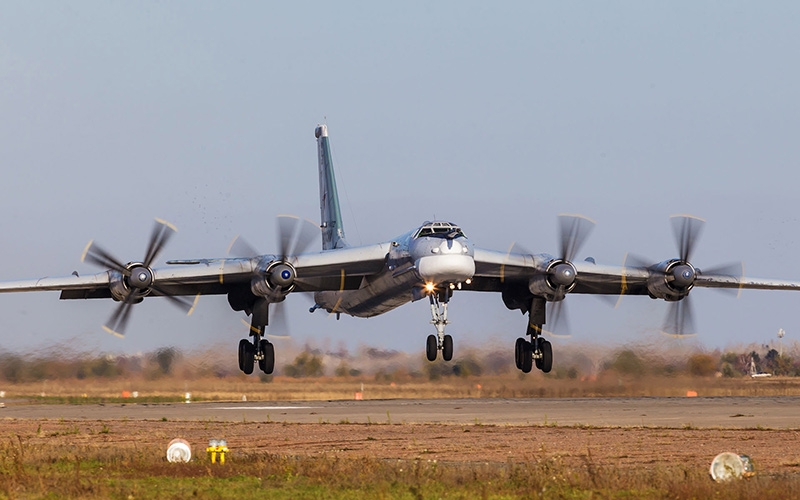
flight control system
Elektrogidromehanicheskaya. It includes two yoke and two pairs of pedals, related to the management bodies of hard-wired - rods and rockers and a flexible cable runs, partially applied in the control channel ailerons and rudder. To reduce the effort on the steering wheel and pedals to the control system includes reversible hydraulic actuators, SU-62M and SU-54M, actuated by hydraulic low pressure. Each channel includes a control system actuators (servos) AP-15 electric autopilot.
On the ground, during the stay of the aircraft all the steering wheels and flight controls using the stopper locking knob, mounted on the side remote commander for RUD. All controls are fitted with trimmers. Trimmers ailerons and rudder simultaneously perform the function of servo tab. Control elevator trim double (by-wire or rope). trimmers Management rudder and ailerons - by-wire.
Tu-95MS management system is largely changed. Introduced spring zagruzhateli, mounted in the longitudinal channel effect trimming mechanism MET-4M DC (it does not require an electronic control unit). The control wiring included two-way damping system aeroelastic vibrations SC-142 (complex machines) a type of "sliding thrust" the executive units of the RAD-107A, wherein the channel is entered automatically yawing moment countering, failure occurs when outer engine on takeoff, rudder deflection by a predetermined angle.
Cabin Tu-95
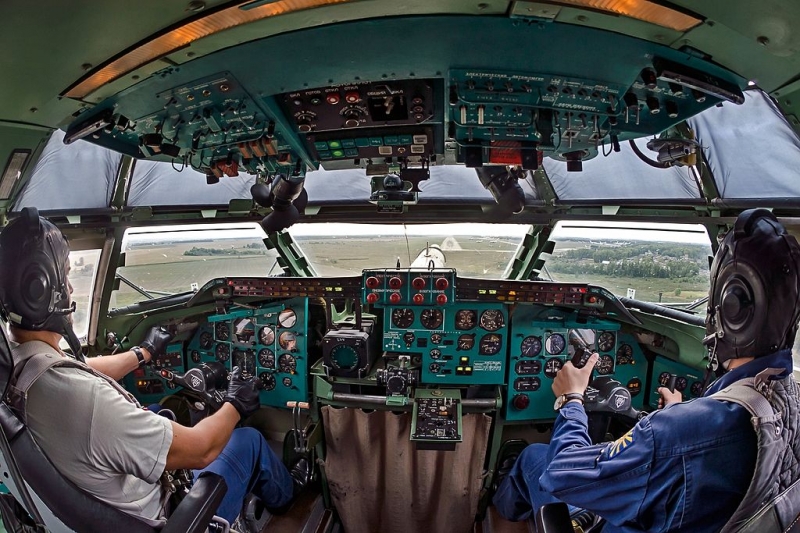
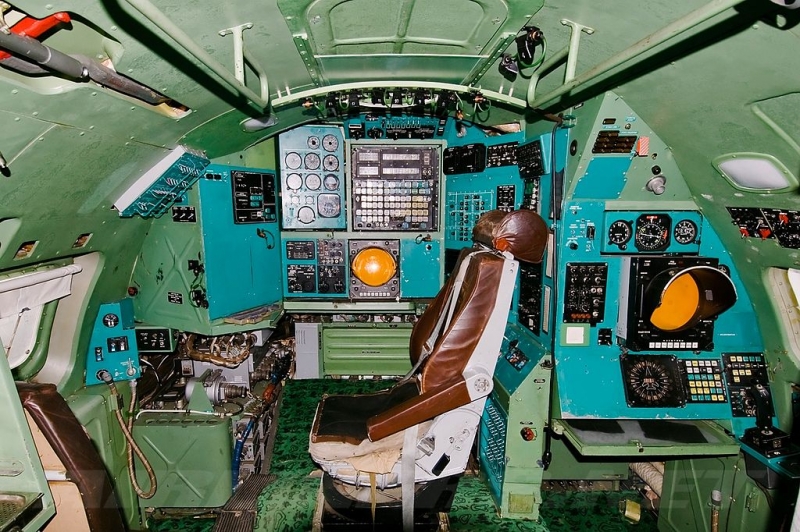
Place the navigator Tu-95MS
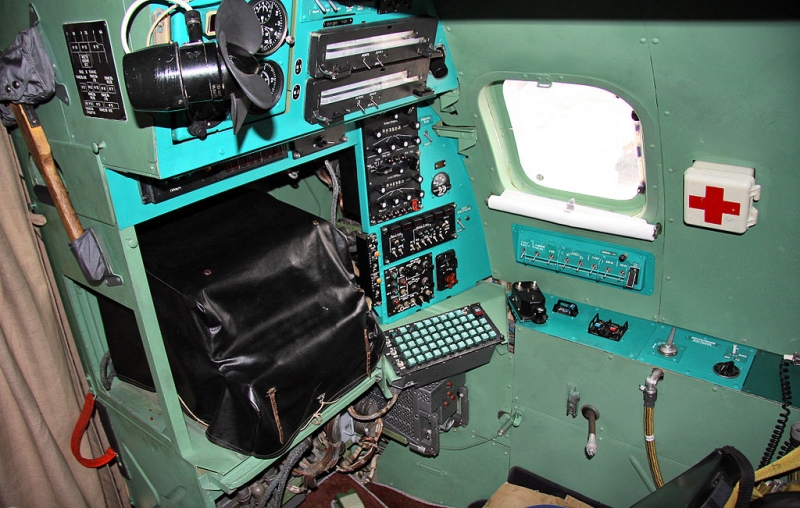
City bortradista Tu-95MS
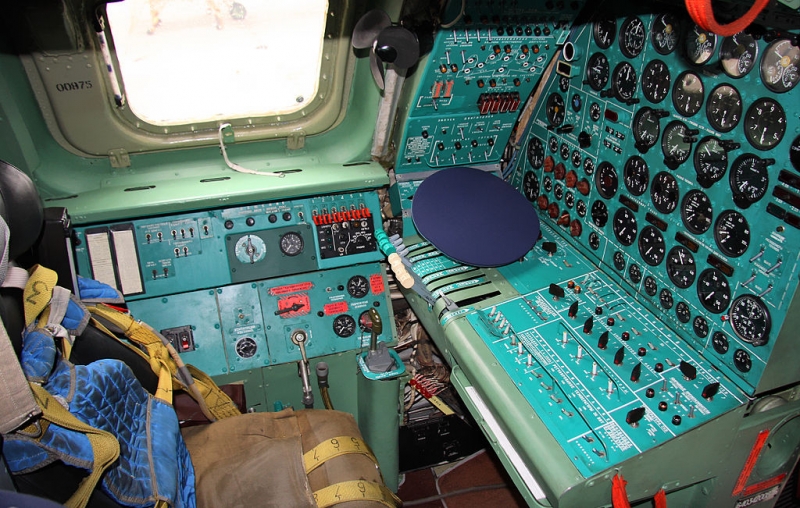
Place a flight engineer Tu-95MS
the hydraulic system
It consists of two independent hydraulic circuits - high and low pressure. High pressure heavy (120-150 kg / cm²) Hydraulic powered by an autonomous electric drive station "unit 465A" (gidropompa) and provides primary and secondary braking wheels, cleaning and release of the nose landing gear, turn the front wheels, raising and lowering of the tower top gun mount, Drive Windshield glass from pilots and moving floor drive. Low pressure hydraulic booster (75 kg / cm²) powered by two hydraulic pumps 437F, mounted on the internal motor drive and serves for the supply of reversible hydraulic actuators in aircraft control channels. The oil in both GS - AMG-10.
Additional GS on the Tu-95MS
On a Tu-95MS in vnutrifyuzelyazhnyh suspension (inside gruzootseke) use Multi-ejection device - drum launcher turret type MKU-6-5, to which the suspension can be up to 6 cruise missiles (system almost similar to those used on a Tu-160). When starting several missiles ISU after uncoupling, each time rotates on 60 degrees, establishing regular rocket straight down gruzootseke. Tu-160 ISU operates from standard hydraulic system of the aircraft, and Tu-95MS HS with at least similar parameters on board there, so to ensure the functioning of the ISU established autonomous hydraulic system with two electric self-contained electro-hydraulic installations (AEGU) - main and backup. Each consists of a tank AEGU, two HC-46 and sensors pumping stations, powered three-phase current 115/200 AT, 400 Hz.
air system
A source of compressed air on board, with a working pressure - 150 kg / cm², are air piston compressors AK-150NK, mounted on the engine drive. The consumers of compressed air are the following systems: Emergency release of the nose landing gear, emergency opening access hatch front pressurized cabin, emergency fuel dumping, Control pressure relief valve in the pressurized cabin, electronics units turbocharging, Emergency generators closing purge valves when the engine fire, Air reloading guns AM-23 guns (GS-23 recharges pyrotechnic cartridges PPL).
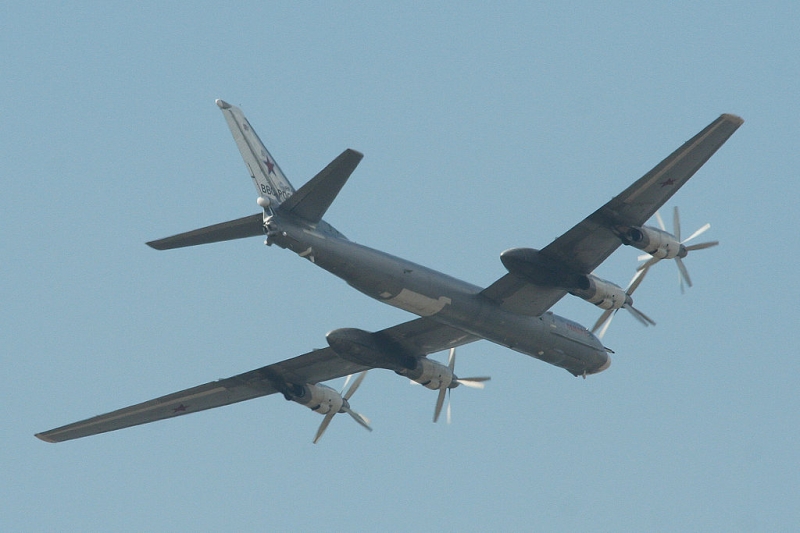
defrost system
It includes several subsystems - the electric-socks wing system, socks tail, the leading edges of rotor blades, fairings bushings screws, Receivers total pressure, front glass cockpit; socks heating system of the engine hood and inlet guide vanes (VNA) compressor motors - hot air, bleed from the 14th compressor stage motors; signaling system starts icing input channels engines, CO sensors 4A, installed in the input ducts of engines and radioisotope detectors icing.
fire protection system
It includes subsystems - automatic and manual fire-fighting in pressurized compartments of the aircraft (fire extinguishers type OS-8M with Freon), extinguishing in nacelles, Fire alarm MSP-2A and five hand-held extinguishers type DU into hermetic aircraft cockpits. The aircraft to prevent the explosion of fuel tanks installed in contact shells eight carbon dioxide cylinders ASU 5-neutral gas system, additionally used as a fire extinguishing agent.
electrics
It consists of a constant current source, unstable AC source frequency, AC sources stable frequency, electricity distribution network and power consumers.
Main DC link powered by 8 type-18000M generators GSR (two for each motor), emergency source core network - two batteries 12SAM-55. Primary AC power, four generators powered by AC frequency astable type CDF-30U (one for each motor). Two secondary AC stable frequency, Powered by two single-phase inverters type PO-4500 and the three-phase converter type PT-1000, or from three-phase converters type PT-70 (PT-125) and PT-600 (Tu-95 and Tu-95M after modernization in 1970).
The electrical network - single-wire. Power wiring to reduce the weight of aircraft airframe formed on the aluminum wires.
VP family of aircraft electrical system, including Tu-95MS, It differs considerably from that described.
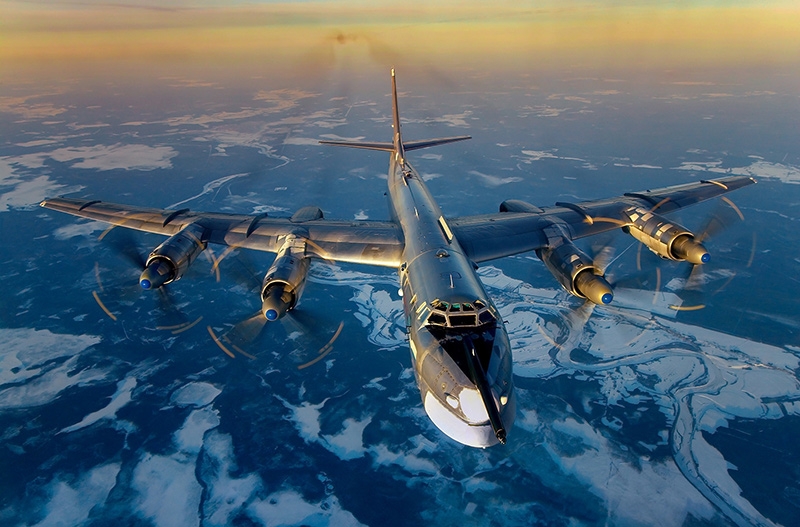
instrumentation, highrise, photographic equipment (PVFO)
Combination Indices speed ASC-1200, altimeter VD-20, variometry VAR-30, maxmetrı MS-1, alarm rate set CCH-8, attitude indicator AGD-1, pointer pitch angle UUT, TSGV-type vertical gyroscope 10, electric trafficator EUP-53, the central rate and the height of the EVC-1M, giropolukompas HPA-52, KI-13 magnetic compass, Aviation Chronometer 13-20CHP, Index altitude and differential pressure UVPD-15, air flow-46U RVU, outdoor air thermometers TNV 15 and TNV-45, air thermometers TRU-48, TV-45 and 11-2Tue; AM-10 Accelerometer, altitude indicator BC-46, position indicator flaps SPD-47, Clock type ASF-1.
Gauges powerplant - thermometers exhaust gases 2TVG-366, oil thermometer 2TUE-11, Fuel gauges 2EDMU-3, oil pressure gauges 2EDMU-10, electrical tachometers 2TE9-1M and TE-40, manometers rods MT-50, Fuel lever position indicator UPRT-2, electrical remote oil level gauge ME-95D, time counter works engines ICH-61, position indicator flaps have oil cooler-03-4.
Oxygen equipment includes aircraft: Stationary oxygen devices CP-24M with an oxygen mask KM 32 for each crew member, parachute oxygen devices KP-23, Four sets of liquid oxygen gasifiers CSW-30, oxygen equipment movement CAP and on-board oxygen valves KAB-16.
The on-board system of registration of modes of flight type MSRP-12-96 (IFRS-12B) and three-component type K3-63 recorder.
Photographic Equipment: aerocamera AFA-42/100 for performing oilfield photoreconnaissance, mounted on the fuselage swash fotoustanovke, between trowels. № 67 and um. № 69.; flares or type FOTAB SAB, for photographic reconnaissance and control bombing at night. The screen can be fixed radar fotokontrolya fotopristavka PHARM-2A.
Dosimetry equipment includes a standard onboard dosimeters such as DP-3B.
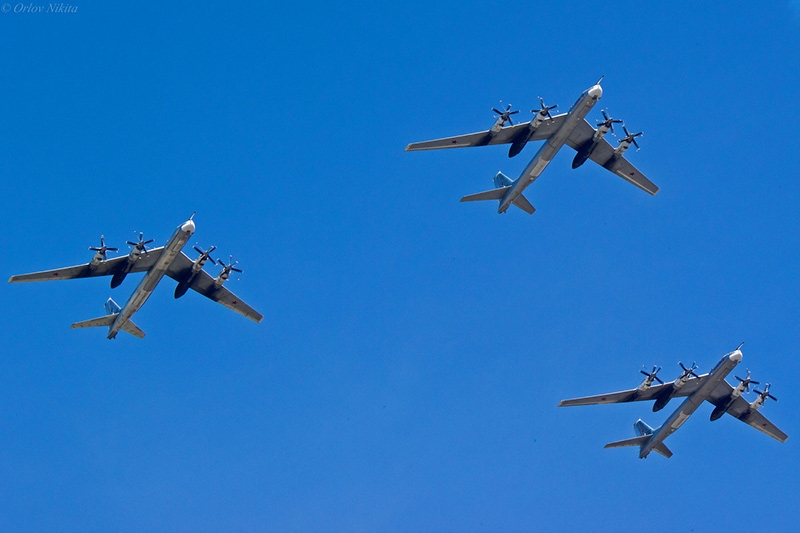
Navigation and flight equipment
Autopilot AP 15B, flight control and navigation system "Path-1B", central navigation-computing device TSNVU-I-I, exchange rate system COP- 6D, Stars and solar tracker BC-63A, remote celestial compass DAK-DB-5, Astronomical compass AK-53P, Aviation periscope sextant SP-1M.
Avionics
Avionics (avionics) Tu-95, purpose and principle of operation is divided into three groups: radio communication, radio navigation and radar. In the process of modernization of aircraft repeatedly changed.
Radio communication equipment It includes: command to the radio R-837 and R-807 (1RSB-70 and 5-RSIU), for long distance in the NE and SW wavebands, command station, operating in the short and medium wave range, command the VHF radio type P-802, for communication in the UHF band, emergency radio R-861, Jets intercom SDA-14 (CPS-10G), voice recorder (record player) MC-61B.
radio navigation equipment It includes hardware and system: automatic direction finder such as ARC-5 (or ARK-11), radio-compass ARK-U2, radio altimeters altimeters type RV-PA (or RV-5), altimeter great heights such as PB-25A, Doppler velocity and drift Diss-angle type 1; based radio navigation and landing - radio systems near navigation RSBN-2CB, radio systems (equipment) Long Range Navigation type ADNS-4 (ADSNS-4), onboard equipment type blind landing system SP-50, flight instruments in the structure of the A-327.
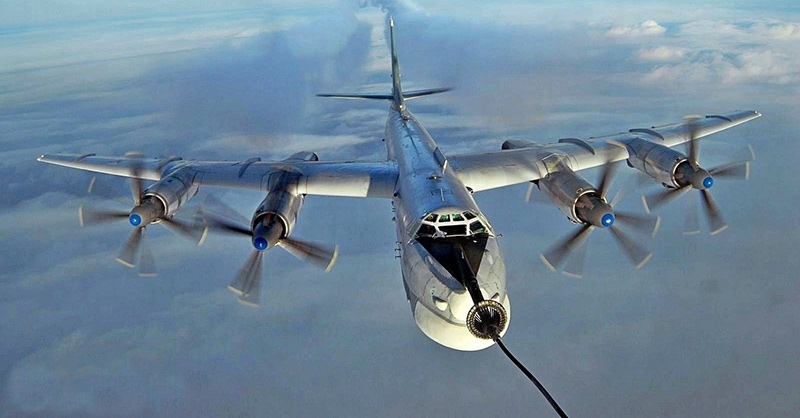
radar equipment
It includes panoramic radar (radar) BPR-2 "Rubidium-MM", conjugate through prefix "Cesium" bomber with the optical sight OPB-5 (Tu-95 and Tu-95M), hereinafter 0PB-11RM (OPB-112) bombing sight or radar type BPO-4 "Rubidium-MM-2"; radar rifle type sighting station AR17 CP-1 "Argon" (in later versions - 4DK CP-4 "Krypton"); Jets radar interrogator-transponder type SRZO-2M; Jets radar transponders type SRO-2P; Jets transponder type SB-69; station (equipment) notification of irradiation aircraft radar enemy type SPO-2 ("Sirena-2»); SPS-1 electronic countermeasures equipment (PCA-2).
Tu-95MR is equipped with radar "Rubin-1D";
Tu-95M-5 is equipped with a radar "Rubin-1Q" ("Volga" system);
Tu-95K is equipped with radar izd.20 "POISON";
Tu-95K-22 - set "PNA" radar (system "Kama");
Tu-95MS is equipped with radar ed. U009 “Overview”
Means Intelligence and reconnaissance Tu-95RTS - Jets hardware system "Success-U" (Jets-board kit consists of PLC Omnidirection, broadcaster, receiving and decoding equipment anchor channel (defendant)); electronic intelligence station "Rhombus-4" letter "A" and "B" (CDS-6 and the CDS-7) and station "Box 2" (CDS-4); station radiorazvedki «Višnja» (CDS-5).
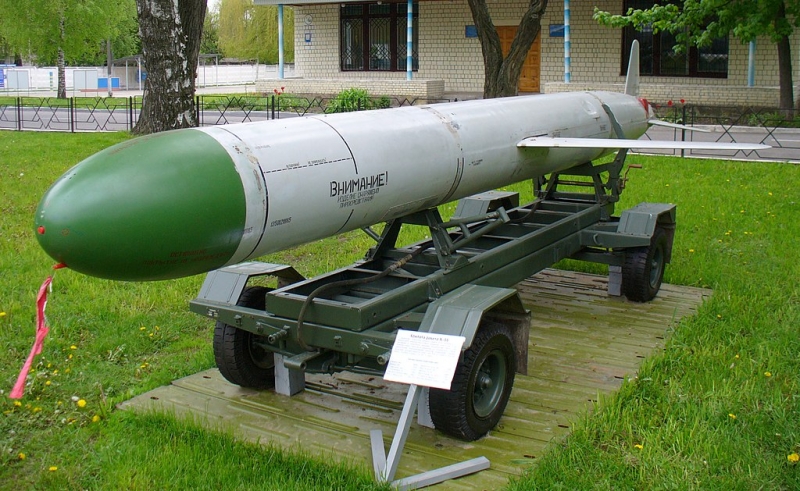
Strike weapons Tu-95MS - cruise missiles X-55
Armament of the Tu-95
Tu-95 bomb load normal 6 tonnes, to a perehruz 12 tons or more. The aircraft has a heat stabilized gruzootseke, which can be accommodated svobodnopadayuschih (including nuclear) bombs caliber up 9000 kg. Tu-95MS has no sighting equipment for use svobodnopadayuschih ammunition.
Tu-95KD and TU-95-20 cruise missiles armed X-20 nuclear warhead, designed to defeat radiocontrast targets at distances of 300-600 km.
Tu-95V (It exists in a single copy) It was converted for use as a means of delivering the world's most powerful thermonuclear bomb. The weight of the bomb was 26,5 tons, and the power of TNT - 50 megatons. After the test, the king-bomb 30 October 1961 , this plane more than for its intended purpose has not been used.
Tu-95K-22 I could carry three X-22 cruise missiles, two on the external load and one - semi-flush in the cargo hold.
Tu-95MS, It forms the backbone of Russia's strategic aviation, a carrier cruise missiles X-55. In a modification of the Tu-95MS6 in the cargo bay to the rocker launcher drum located six such missiles. In a modification 95MS16-Tu, in addition to the launcher provided vnutrifyuzelyazhnyh suspension More ten missiles X-55 for four holders and mounted underwing Suro (missile weapon control system), similar to the Tu-160. Equipment svobodnopadayuschih ammunition from the plane dismantled.
Tu-95MSM modified for use missiles X-101 and X-102, and holders have inner and outer suspension.
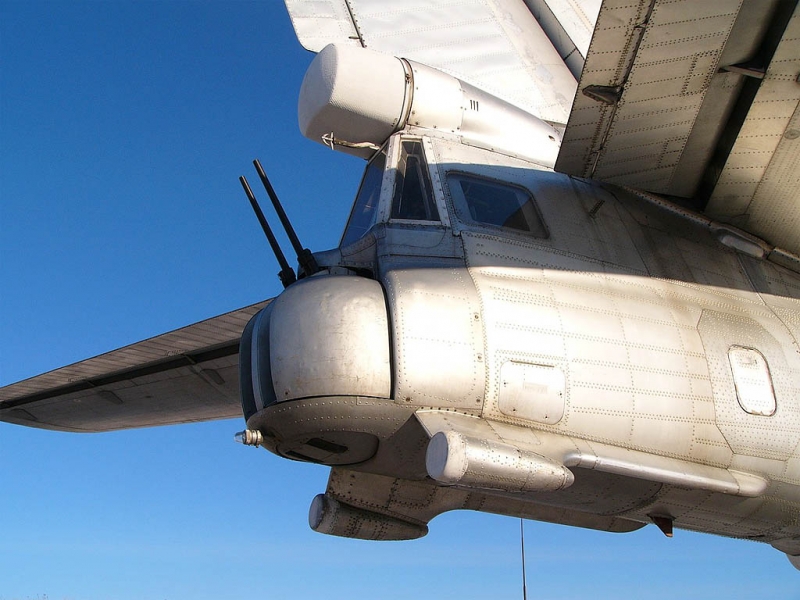
Fodder plant with guns AM-23
defensive armament TU-95 consists of a 23-mm aircraft cannon.
On older versions of the aircraft system is installed PV-23 (9-A-037) six twin guns AM-23 in three defensive shooting settings (upper DT-B12, lower DT-H12, and feed the DC-12). Tu-95K-22 instead of the DC-mounted apparatus 12 EW. On modifications Tu-95MS mounted one aft installing DC-12 (9-TO-037) a pair of guns 23 or AM system installation aft 9-K-502-II (Modification of IL-76), Two twin-barrel cannon GS-23.
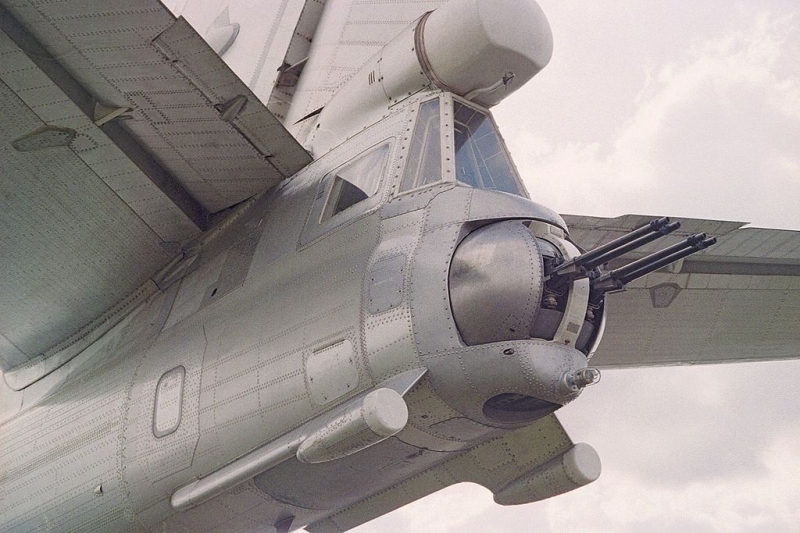
Fodder plant with cannon GS-23
Tu-95 modification
«95-1» – The first experimental prototype with theater 2TV-2F (1952 year).
«95-2» – The second experimental prototype with theater TV-12 (1955 year).
Tu-95 (ed. "AT") – Continuous modification of the strategic bomber with a bomb armament, built on the basis of the second "95/2" pilot airplane (1955 year).
Tu-95 (order 244) – Serial Tu-95M with increased fuel.
Tu-95A (Bear-A) – Strategic bomber - carrier of nuclear weapons with special color, heating system and thermal insulation bomb bay, light shielding shutters crew (1956 year).
Tu-95V (order 242) – Converted serial Tu-95, designed for heavy duty test (50-100 Mt) thermonuclear bomb (1959 year).
Tu-95K (Products "VK", Bear-B) – Bomber carrier X-20 supersonic cruise missiles, included in the complex K-20 (1956 year).
Tu-95K-22 (Products "VK-22") – Modification serial TU 95km-carriers in KR X-22, missile system K-95-22.
Tu-95KD (ed. "EVA") – Modification model TU-95K - bomber carrier cruise missiles X-20 - additionally equipped flight refueling system (1961 year).
Tu-95KM (product "ECM", Bear-C) – Upgraded perevooruzhonny and X in the CD-20M embodiment Tu-95KD with renewed avionics (1968 year). One Tu-95km was transformed into an experimental prototype vehicle 105.11 Project "Spiral" aerospace systems (Total projected three experimental products - subsonic, supersonic and orbital. The project closed in the late 1980s).
Tu-95KU (product "UWC") – Study modification of the Tu-95K, used for training crews use of K-20 to X-20 cruise missiles (1956 year).
Tu-95LAL (order 247) – Converted from Tu-95M in a flying laboratory for the program to create the aircraft with the nuclear power plant. By airplane crew worked out the biological protection against radiation.
Tu-95M (Products "VM") – Continuous modification of the strategic bomber with engines NK-12M, constructed 19 machines (1957 year).
Tu-95M-5 – The prototype - the carrier KR DAC-5.
Tu-95M-55 – Converted from Tu-95M-5 flying laboratory for complex debugging Tu-95MS X-55 rocket.
Tu-95mA – Prototype testing of promising missiles based on the Tu-95MS.
Tu-95MR (Products "VR", Bear-E) – strategic intelligence, constructed 4 cars (1964 year).

Tu-95MS and MiG-29
Tu-95MS (Products' VP-021», Tu-95MS-6, Tu-95MS-16) – Aircraft carrier cruise missiles X-55 (1979 year later). It is based on the Tu-142MK.
Tu-95MSM – Modernization Tu-95MS-16 engines replaced by modification with SC-12MVM AV screws 60T. modernization BKO ("Meteor-NM2"). Install new navigation computer system SIS-021M, integrated control system KSU-021, SDI display information system-021, ANS-2009 astro-navigation system, Radar "Novella-NV1.021" . By plane options the external suspension 8 missiles X-101 or X-102. The first plane w / 20k reg. RF-94122 ("Dubna") I was ready in autumn 2015 of the year.
Tu-95N (order 236) – The aircraft carrier suspended strategic bomber development of MS KB P. AT. Cibin (1956 year).
Tu-95RC (Products "VC", Bear-D) – Scout-pointer for the needs of the Navy, constructed 53 cars (1962 year).
Tu-95U (Products "VU") – Training modification of the Tu-95 and Tu-95M.
TU-96 – high-rise (a working ceiling 16 000-17 000 m) bomber with increased wing area and theater TV-16, able to maintain its performance at these altitudes. 29 Martha 1952 g. came the corresponding decision the Council of Ministers. The aircraft will be built in two copies with the transfer of the first to the factory tests in July 1954 g. and government - in December of the same year. OKB-276 was obliged to transfer TV-16 bench tests in January, and in Flight - in June 1954 g.
Tu-114 (Cleat) – airliner (1960 year).
Tu-115 (Tu-114VTA) – Military transport aircraft (project).
Tu-116 (Tu-114D) – airliner (1956 year).
Tu-119 (project) – flying lab, plane with two experimental nuclear power plants NK-14A and two full-time NK-12M, as part of a anti-aircraft with Yasu (1974 year).
Tu-126 (product "L", Moss) – AWACS plane (1962 year).
Tu-142 (Products "VP", Bear-F) – Far ASW aircraft (DPLS), created based on the Tu-95RTS (1963 year)
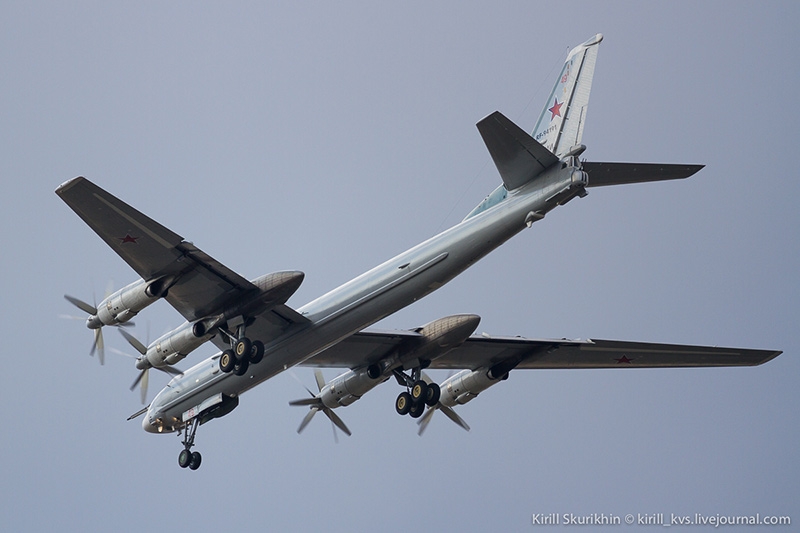
dislocation places
After the collapse of the Soviet Union in Russia formed the 37th Air Army aircraft of strategic purpose of the two divisions - a 22 dc. TBAD Engels (Saratov region.), which included 121 dc. TBAP on the Tu-160 and 184 polk Tu-95MS-16. Second Division - 326 dc. TBAD in Ukrainka (Amura.), of 182 dc. TBAP and 79 TBAP.
Exploitation
Development and operation of the airplane accompanied by considerable difficulties. The cabin was poorly adapted to long flights. Uncomfortable seats and a toilet - a portable tank with commode, dry and oil-polluted air with dust - all this led to premature fatigue of crews. In a modification of the Tu-95MS portion drawbacks has been corrected.
Particular problems arise in the operation of aircraft in the winter. The engine oil system SC-12 is poured a mixture of mineral oil (MS-20 and MK-8), which is at a temperature below 0 degrees thickens as, that it is impossible to turn the screws. Therefore, before each flight, all engines were warmed up by ground motor heater (heat guns). In their absence, (eg, at an operational airfield) motors refuge insulating covers and runs every few hours - to warm up, which has a negative effect on the life and exhausting personnel. In the late 1980s, the industry began to produce special motor oil - MH 7,5U, allowing engine start NK-12 at -25 degrees frosts. With the collapse of the USSR the production of this oil is practically minimized. In the modified portion in the Tu-95MS forkil installed auxiliary power unit, allows you to select the air for heating preflight engine.
Replacing the engine NK-12 is extremely labor-intensive, in comparison with other types of aeronautical engineering, and it has the characteristics of mass, It requires some qualification of the personnel and skills.
By plane constructively missing crew ejection system, which seriously hinders the bailout of the incident aircraft in the event of an accident.
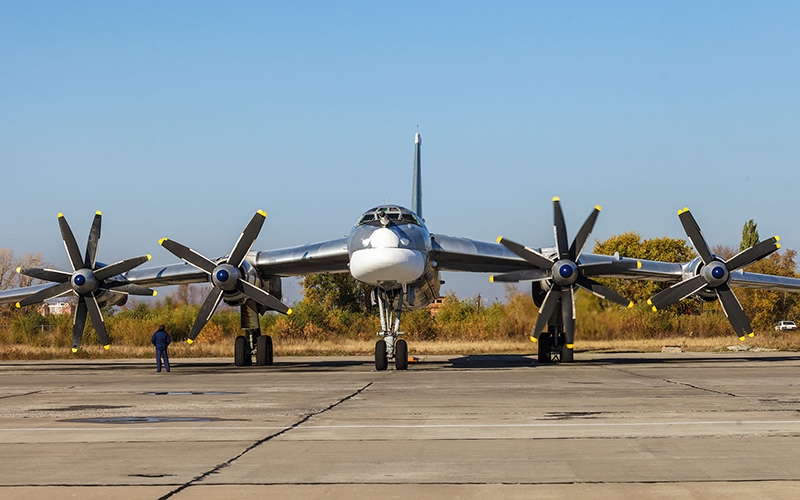
Service
formation 106 TBAD in Uzin in the Kiev region began in 1955 year. First Division Regiment was formed at the end of the year - 409 TBAP. He exploited the Tu-95, Tu-95M, Tu-95MR, Tu-114, Tu-116 to 1986 of the year, then re-equipped tankers on IL-78. The second regiment of the division - 1006 TBAP, It was formed in 1956 year (Tu-95K, Tu-95KM and Tu-95K-22, from 1985 year - Tu-95MS).
Also Uzyn was formed 1223 TBAP new 79 TBAD (1956 year), and then 182 Guards TBAP on the Tu-95K (in the future - Tu-95km and Tu-95K-22). 182-th regiment based in Mozdok, by the end 1988 perevooruzhon, I was on the Tu-95MS, after the collapse of the USSR perepodchinon division Engels. 1223 TBAP in 1957 year, together with the management of the division flew to Semipalatinsk, I had on the Tu-95 armament, Tu-95M, Tu-95MR, Tu-95V, Tu-116. Polk first YES rearmed on the Tu-95MS in 1982 year. The second regiment of the division - 1226 TBAP flew on the Tu-95, Here m-95 and Tu-95K-22, from 1984 year - Tu-95MS. Based in Semipalatinsk.
106 TBAD worked on the northern direction, until Arctic, whereas machines 79 TBAD intended for attacks on targets in the south - NATO bases in Asia and in the Indian Ocean, and in the future, and on targets in China.
several planes (squad) constantly in a state of combat duty. For rapid suspension of large-sized nuclear weapons were equipped with parking trenches - in shelves alert was called - "in the hole". Initially armed with 95's were trohmegatonnye bomb - "article 37", subsequently replaced by the more bulky dvadtsatimegatonnymi products - hence the duty "in the hole".
Because of the large difference in time approach of American bombers from NATO air bases in Europe and Asia to the targets in the Soviet Union and the Soviet Tu-95 from their airfields to targets in the United States, in the Soviet Air Force began to be practiced methods of "withdrawal from the blow". It was meant, dispersal of aircraft in case of an attack on the operational airfields, including, and specially equipped snow airfields in the Arctic (the first studies were carried out at the station "North Pole-2"), and then applying retaliatory "retaliation". On this topic was carried out a lot of research and practice.
In the 1960s, the Tu-95 was intercepted by a British fighter Lightning, while maneuvering a British bomber plane crashed.
Also in the 1960s, carried out low-altitude flights of bombers groups to "break defense". Specially trained crews of combat units performed flights at an altitude of several hundred meters, below the zone of visibility of the radar period,.
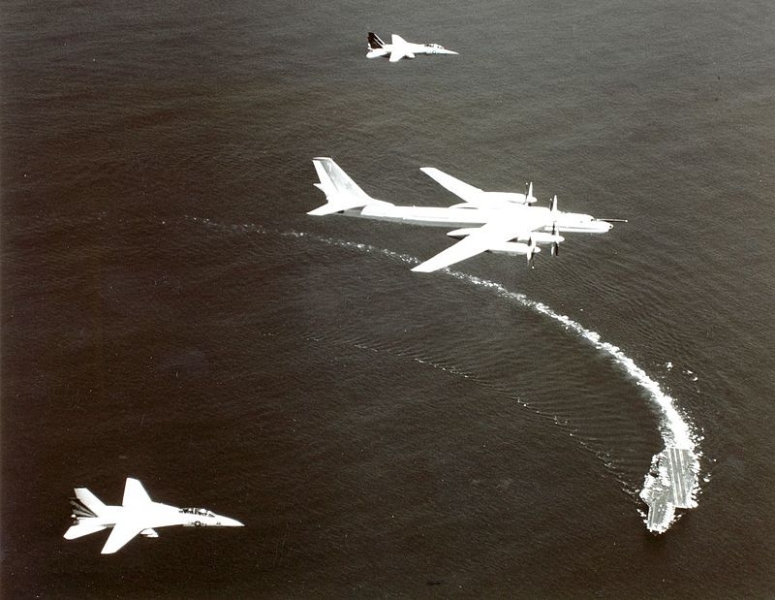
American fighters (Grumman F-14A) escorted the Tu-95, In the background - the aircraft carrier «Kitty Hawk»
In one flight over the Atlantic Soviet Tu-95 was intercepted by three American fighters F-4 "Phantom". Trying to fly a plane, American hit in the tail wing and lost control. The pilots ejected and "Phantom" crashed, Soviet aircraft successfully returned to the airport.
Tu-95MR (all built 4 aircraft) conducted regular reconnaissance in the Atlantic, and then in the Pacific Ocean, why planes were distilled in the northern and Far East airfields Soviet Union and the former US Air Base in Vietnam (Pin It, Kamranь). Subsequently to perform these two tasks Navy shelf planes were formed on the Tu-95RTS - 392 Throws the book in Kipel (Vologda) and 304 ODRAP in Khorol (Primorsky Krai). The intensity razvedpolotov Tu-95RTS was so high, NATO sailors came to be called the plane "Orient Express".
After upgrading to the Tu-95MS were performed demonstration flights - nonstop flyby around the perimeter of the borders of the USSR and the flight to the US border and Canada via the North Pole. "MS-s" were reported in 106 TBAD and 79 TBAD, changing the old modification of the Tu-95. Relatively fresh missile carriers Tu-95K and particularly the Tu-95K-22 was transferred to the Far East, where in the Amur region (Ukrainka) It was formed 73 dc. TBAD, with the formation of two regiments - 40 dc. TBAP and 79 dc. TBAP. The objectives of the Division aircraft carrier strike groups were (AUG) in the Pacific.
After the collapse of the Soviet Union regiments from Kazakhstan managed to overtake in Russia. AT 1998 , Ukraine has started to destroy it inherited strategic bombers on selected US Nunn-Lugar funds, but after negotiations, Ukraine gave Russia eight Tu-160 and three Tu-95 (and a party cruise missiles) in return for the cancellation of the debt on gas purchase. Three Tu-95MS were left in Ukraine, all the rest - disposed. One of them now acts as a museum exhibit in the museum distant Poltava and strategic aviation. The other two were converted to reconnaissance aircraft and delivered for safekeeping near Nikolaev Aircraft Repair Company. In August 2015 it became known, what these 2 aircraft were to end 2013 year sold to unknown buyers.
Formed in the Russian Federation 37 Air Force aircraft of strategic purpose of the two divisions - a 22 Guards TBAD Engels (Saratov region.), which included 121 dc. TBAP on the Tu-160, and 184 polk Tu-95MS-16. Second Division - 326 dc. TBAD in Ukrainka (Amura.), of 182 dc. TBAP and 79 TBAP.
Tu-95K № 48000001 transferred to Chelyabinskoye School navigators.
Tu-95 Head. № 5800101, Release date 31.08.55 city, on display at the Russian Air Force Museum in Monino.
Tu-95km number 63M52607 operated as a flying laboratory in the GK NII VVS in Vladimirovka, test program orbital rocket plane "105.11".
Tu-95VK-22 (KAMA b / n 53) Number ...... 2704 at the extreme dislocation garrison Diaghilev exhibited in museums garrison Engels long-range aviation
Tu-95MS Tambov (b / n 23) Number ...... 0843 at the extreme dislocation garrison Diaghilev transferred to the Voronezh Institute of Aviation
According to preliminary information, for robbery during operation 25 machines Tu-95 of various modifications.
On 2012 year combat capability only 32 Tu-95MS. About 60 planes are on standby. Upgrade to 'MSM' level subject only Tu-95MS-16, which are equipped with the missile "Octopus" system, they will be able to carry the Kh-101 missiles and serve to 2040 of the year.
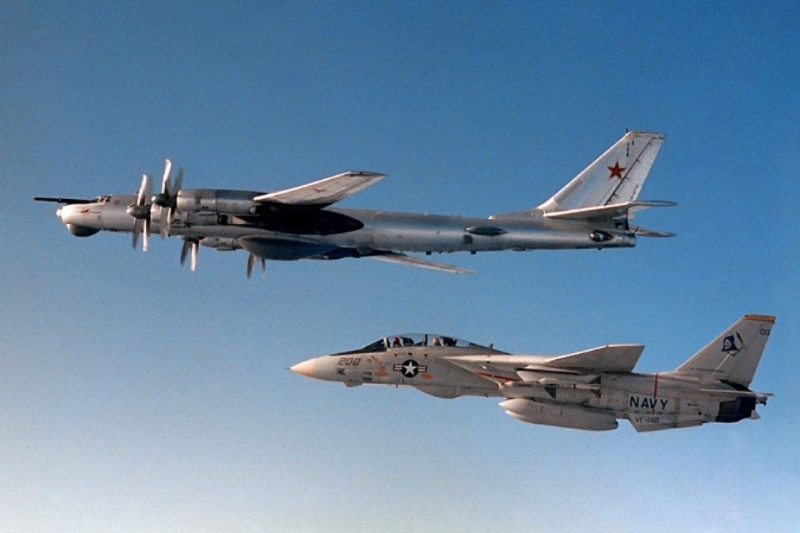
F-14A «Tomcat" carrier-based fighter, based on the nuclear aircraft carrier "Dwight Eisenhower", accompanies the Soviet strategic bomber Tu-95
incidents
2000-it is
Since 22 April 3 May 2007 , two Russian Tu-95MS incident became participants, occurred during the exercise of the British Army "Neptune Warrior", conducted in the Gulf of Clyde North Sea near the Hebrides. Russian planes appeared in the area of exercise (carried out in international waters), then airbase Lyuashar in the Scottish region of Fife two British fighters have been raised. Fighters accompanied Russian planes, until they left the exercise area. According to the representative of the RAF, it was the first such case since the end of the Cold War.
In August 2007 , the Tu-95MS flew during exercises near the US Navy base on the island of Guam in the Pacific Ocean, in July - in close proximity to the air borders on the UK North Sea, a 6 September, the British fighter had met just eight Russian bombers.
On the night 9 on 10 February 2008 , four Tu-95 took off from the airbase "Ukrainka". Two of them flew close to the air borders of Japan and one of them, on the Japanese side claims, nominated later protest note, three minutes trespassed. The second pair of planes headed for the aircraft carrier "Nimitz". When the Russian aircraft to the ship was about 800 km, intercept four variety F / A-18. On distance 80 km from the aircraft carrier group American planes intercepted a Tu-95, but despite this, one of the "bears" twice passed over the "Nimitz" at an altitude of approximately 600 m.
Similar cases in international waters have become quite often occur after the resumption in August 2007 year regular flights of strategic aviation in the air patrol. The press usually illuminated each case, and NATO countries, such incidents are considered "acts of provocation in the spirit of the Cold War".
US State Department spokesman Sean McCormack said, that if Tu-95 still flying, they "are in good working order", and added: "I do not think, we believe it is especially threatened, but we This is followed by, carefully observe, and I am sure, that the Pentagon at this watch, too. "
According to Admiral James Vinnefelda Jr., the head of US Northern Command and the Chief of North American Aerospace Defense Command, flights of the Tu-95 aircraft near the US border and Canada - "it is as if there is an illusion of power, where there is no power. They are trying to show the world, they are a powerful nation, and we do not give them the satisfaction ".
21.08.2014 g. Japan raised the fighters to intercept two Russian Tu-95. The bombers approached the border area, Russian Air Force airplanes but the country's airspace is not breached, According to Japan's Ministry of Defense. According to the military department, Russian planes have bypassed the border around the perimeter and flew in the direction Sakhalin.
01.11.2014 g. Portugal for the second time this week raised the F-16 fighter, to intercept Russian bombers Tu-95, seen in the international space off the coast of the country, next to the southern borders of NATO.
01.11.2014 g. Britain raised Typhoon fighters to intercept a number of Russian Tu-95 in international airspace near the UK Borders.
28.01.2015 g. Two Russian Tu-95 were found in the UK Air Defense's area of responsibility south of Bournemouth town on the shores of the English Channel. The two fighters Eurofighter Typhoon of the Royal Air Force were scrambled to intercept and accompanied by Tu-95 to exit from the zone of responsibility. In connection with the incident, the British Foreign Ministry summoned the Russian ambassador for an explanation.
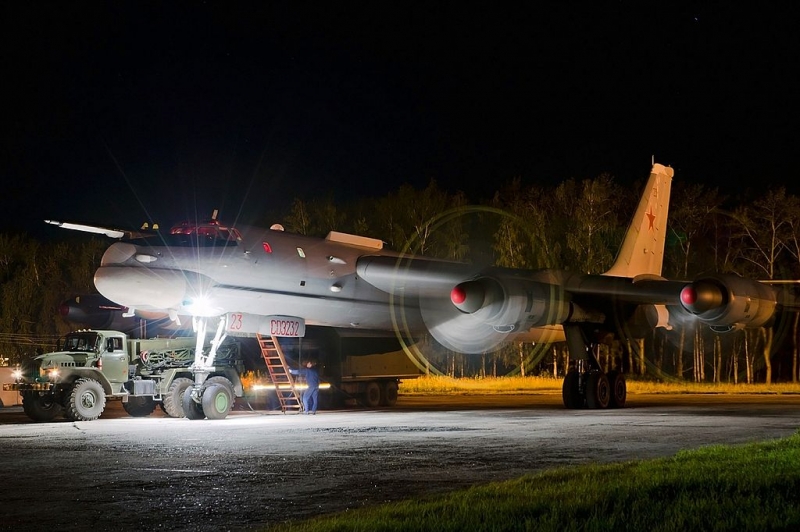
Tupolev TU-95-142, Ryazan – Dyagilevo RP129470
armed with
It is in service
Russia - 48 Tu-95MS and 12 Tu-95MSM, as of 2017 year.
AT 2013 It was a modernization of the Tu-95MS-16 version of the Tu-95MSM. Upgrade to 'MSM' level subject only Tu-95MS-16, which are equipped with the missile "Octopus" system, only about 35 Flight. Replacing undergo avionics, while, as the airframe and engines will not be subject to refinements. On bombers new sighting and navigation system will be installed, which allow the use of new strategic cruise missiles X-101. Also navigation system GLONASS will. Tu-95MS-6, which are equipped with a missile, "Aspen" system, Modernization can not be. only about 28 Flight. but, according to a source in the "Tupolev", this is not the limit - the Tu-95 can be used successfully to 2040s.
It was in service
Ukraine - 23 Tu-95MS, as of 1993 year. The bombers were in service in 1006 the first heavy bomber aviation regiment, which was based at the airbase Uzyn. The air base has ceased to exist in 1998 year after the Ukrainian government decided to destroy the Tu-95MS, and aircraft refueling tankers Il-78 converted for freight commercial transport.
In 1999-2000,, in accordance with the intergovernmental agreement, Ukraine gave Russia 8 Tu-160, 3 Tu-95MS and 581 cruise missiles X-55 in the Ukrainian debt payment for the delivered natural gas in the amount of $285 million.
To spring 2002 It had been destroyed in the territory of Ukraine 19 Ukrainian Tu-95MS, and 5 Russian Tu-95 (3 Tu-95MS and 2 Tu-95K22), were on repair plant in g. White church, according to the "Agreement between the Cabinet of Ministers of Ukraine and the Russian Federation on the procedure of liquidation and repayment of aviation equipment, located in the repair shops of the Ministry of Defense of Ukraine and the Russian Federation Ministry of Defense ".
To top 2006 the year was also sawn 6 Tu-142, belonging to Ukraine, which were based at the airbase Kulbakino 33rd Center for Combat Use and Retraining of the Ukrainian Air Force (g. Nikolaev) and at the airport of the State Aviation Scientific-testing center Ukrainian Air Force near the village. Kirov (Autonomous Republic of Crimea).
Three Tu-95MS (b / n, 31 and 95) They were converted to reconnaissance aircraft and delivered for safekeeping near NARP (Nikolaev Aircraft Repair Company). AT 2013 , two reconnaissance aircraft have been sold for scrap, a 4 NK-12 MB of them are trying to sell to Russia 2015 year.
Two more Tu-95, given in non-flying state, We remain as monuments: one at the Poltava Museum of long-range and strategic aviation (former airbase "Poltava-4"), the second - in Uzin. As the museum exhibits also remained 2 Tu-142, which can be seen in the State Museum of Ukrainian Aviation and Lugansk Aviation-Technical Museum.
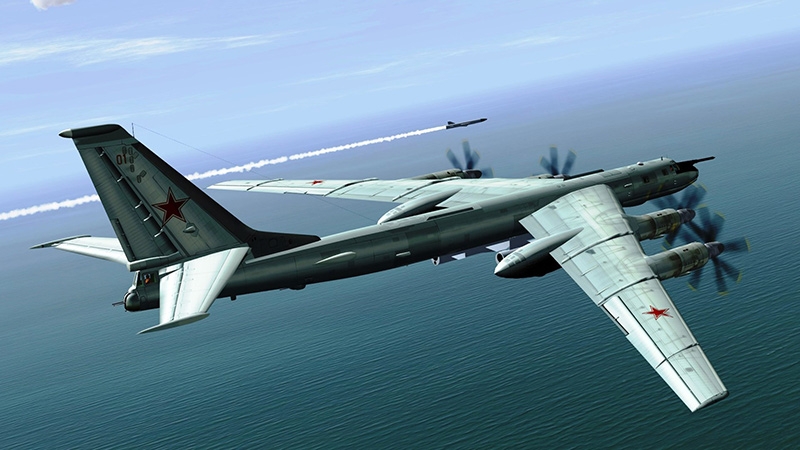
combat application
For the first time the Tu-95MS were used during Russian military operations in Syria during the period from 17 by 20 November 2015 of the year. Strikes by cruise missiles X-55 on the facilities of the Islamic State.
17 November 2016 Tu-year 95MSM attacked the latest cruise missiles X-101 targets of terrorists in the SAR. missile launches were carried out over the waters of the Mediterranean Sea.
5 July 2017 year strategic missile carriers Tu-95MS, coming from the airport Engels, flew to Syria to refuel in the air and hit warehouses and command post militants of the banned terrorist organization in Russia IG latest cruise missiles X-101. The attack was made with the distance to the target of about 1000 km.
Accidents and Disasters
According to preliminary information, in accidents and catastrophes lost 31 Tu-95 and Tu-142, killing 208 man flight crews.
records
30 July 2010 the year set a world record non-stop flight to production aircraft - for 43 hours bombers flew around 30 thousands of kilometers over the three oceans, four times to refuel in the air.
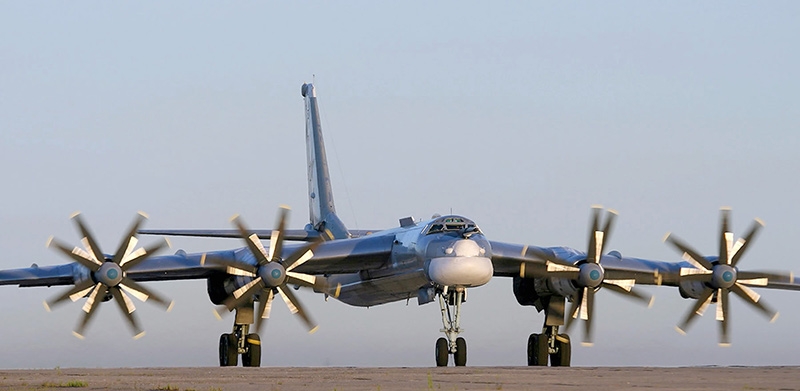
The performance characteristics of the Tu-95MS
The crew of the Tu-95MS
– 7 human
The dimensions of the Tu-95MS
– Length, m: 49,09
– Wingspan, m: 50,04
– wing area, m²: 289,9
– Ratio Wing elongation: 8,84
– Wing loading, kg / m: 638
Weight Tu-95MS
– empty weight, kg: to 98 500
– Maximum takeoff weight, kg: 185 000
– fuel weight, kg: 87 000
Engine Tu-95MS
– Power point: 4 × NK-12MP
– Engine power, kW (l. from.): 4 × 11 185 (15000)
Speed Tu-95MS
– full speed, kmh: 830
– Cruising speed, kmh: to 700
– The length of the run, m: 2540
Practical range Tu-95MS
– 10 500 km
Practical ceiling Tu-95MS
– 10 500 m
weaponry
– Small-pushechnoe: 2×ГШ-23
– combat load, kg (normal / maximum): 7800 / 20 800
Photo Tu-95
